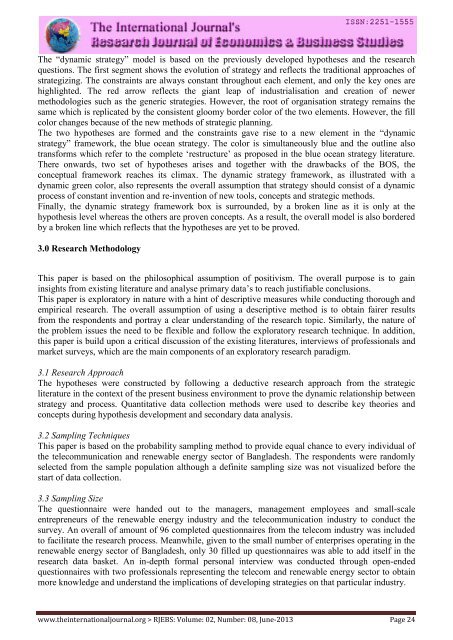Research Journal of Economics & Business Studies - RJEBS - The ...
Research Journal of Economics & Business Studies - RJEBS - The ...
Research Journal of Economics & Business Studies - RJEBS - The ...
- No tags were found...
You also want an ePaper? Increase the reach of your titles
YUMPU automatically turns print PDFs into web optimized ePapers that Google loves.
<strong>The</strong> “dynamic strategy” model is based on the previously developed hypotheses and the research<br />
questions. <strong>The</strong> first segment shows the evolution <strong>of</strong> strategy and reflects the traditional approaches <strong>of</strong><br />
strategizing. <strong>The</strong> constraints are always constant throughout each element, and only the key ones are<br />
highlighted. <strong>The</strong> red arrow reflects the giant leap <strong>of</strong> industrialisation and creation <strong>of</strong> newer<br />
methodologies such as the generic strategies. However, the root <strong>of</strong> organisation strategy remains the<br />
same which is replicated by the consistent gloomy border color <strong>of</strong> the two elements. However, the fill<br />
color changes because <strong>of</strong> the new methods <strong>of</strong> strategic planning.<br />
<strong>The</strong> two hypotheses are formed and the constraints gave rise to a new element in the “dynamic<br />
strategy” framework, the blue ocean strategy. <strong>The</strong> color is simultaneously blue and the outline also<br />
transforms which refer to the complete ‘restructure’ as proposed in the blue ocean strategy literature.<br />
<strong>The</strong>re onwards, two set <strong>of</strong> hypotheses arises and together with the drawbacks <strong>of</strong> the BOS, the<br />
conceptual framework reaches its climax. <strong>The</strong> dynamic strategy framework, as illustrated with a<br />
dynamic green color, also represents the overall assumption that strategy should consist <strong>of</strong> a dynamic<br />
process <strong>of</strong> constant invention and re-invention <strong>of</strong> new tools, concepts and strategic methods.<br />
Finally, the dynamic strategy framework box is surrounded, by a broken line as it is only at the<br />
hypothesis level whereas the others are proven concepts. As a result, the overall model is also bordered<br />
by a broken line which reflects that the hypotheses are yet to be proved.<br />
3.0 <strong>Research</strong> Methodology<br />
This paper is based on the philosophical assumption <strong>of</strong> positivism. <strong>The</strong> overall purpose is to gain<br />
insights from existing literature and analyse primary data’s to reach justifiable conclusions.<br />
This paper is exploratory in nature with a hint <strong>of</strong> descriptive measures while conducting thorough and<br />
empirical research. <strong>The</strong> overall assumption <strong>of</strong> using a descriptive method is to obtain fairer results<br />
from the respondents and portray a clear understanding <strong>of</strong> the research topic. Similarly, the nature <strong>of</strong><br />
the problem issues the need to be flexible and follow the exploratory research technique. In addition,<br />
this paper is build upon a critical discussion <strong>of</strong> the existing literatures, interviews <strong>of</strong> pr<strong>of</strong>essionals and<br />
market surveys, which are the main components <strong>of</strong> an exploratory research paradigm.<br />
3.1 <strong>Research</strong> Approach<br />
<strong>The</strong> hypotheses were constructed by following a deductive research approach from the strategic<br />
literature in the context <strong>of</strong> the present business environment to prove the dynamic relationship between<br />
strategy and process. Quantitative data collection methods were used to describe key theories and<br />
concepts during hypothesis development and secondary data analysis.<br />
3.2 Sampling Techniques<br />
This paper is based on the probability sampling method to provide equal chance to every individual <strong>of</strong><br />
the telecommunication and renewable energy sector <strong>of</strong> Bangladesh. <strong>The</strong> respondents were randomly<br />
selected from the sample population although a definite sampling size was not visualized before the<br />
start <strong>of</strong> data collection.<br />
3.3 Sampling Size<br />
<strong>The</strong> questionnaire were handed out to the managers, management employees and small-scale<br />
entrepreneurs <strong>of</strong> the renewable energy industry and the telecommunication industry to conduct the<br />
survey. An overall <strong>of</strong> amount <strong>of</strong> 96 completed questionnaires from the telecom industry was included<br />
to facilitate the research process. Meanwhile, given to the small number <strong>of</strong> enterprises operating in the<br />
renewable energy sector <strong>of</strong> Bangladesh, only 30 filled up questionnaires was able to add itself in the<br />
research data basket. An in-depth formal personal interview was conducted through open-ended<br />
questionnaires with two pr<strong>of</strong>essionals representing the telecom and renewable energy sector to obtain<br />
more knowledge and understand the implications <strong>of</strong> developing strategies on that particular industry.<br />
www.theinternationaljournal.org > <strong>RJEBS</strong>: Volume: 02, Number: 08, June-2013 Page 24

















